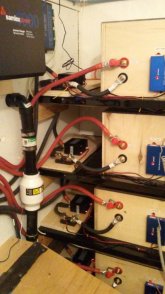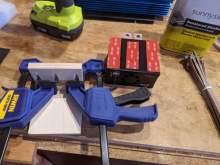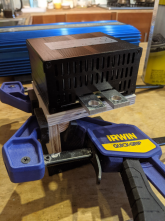Steve_S
Offgrid Cabineer, N.E. Ontario, Canada
There are some very different SSR contactors out there.
From another where I posted about these may help with a Quick Glance. (Craigs SSR Testing)
Now do note the size of lugs here... These are intended for Battery Cables not other stuff eh...
These came out as a result of Craig & I's Relay, Contactor SSR testing q while back. At that time no one had Large Lugs SSRS to actually handle real battery cables. These guys took on the challenge and created this Shown below is the 500A versions I received. After these were made up, and Jason from Chargery had communicated with that Company, he realized it would be prudent to develop the DCC inhouse which is how they came to be in existence. NB: These are Unidirectional Versions suitable ONLY for Split Port config. Bi-Directionals are available but +$$$ and are special order, which would have to goto Manufacturing to be made on req. Both of these versions were made up specifically at my request and my additional expenses.
The Real Deal 500A (1/2" Lugs)


IF you are Curious:
Big Lug 500A SSR : https://www.alibaba.com/product-detail/DC-control-DC-solid-state-relay_62549649837.html?spm=a2747.manage.0.0.3d1571d2AmThhr&bypass=true
Big Lug 1000A SSR : https://www.alibaba.com/product-detail/DC-control-DC-solid-state-relay_62549285366.html?spm=a2700.icbuShop.41413.11.72317242imd258&fullFirstScreen=true&bypass=true
BTW: If anyone is running Separate Port & wants to use these for Control Relays I can make you one heck of a deal, they are only Dust Collectors here. I never used them as I am Common-Port config and we had a misunderstanding (rather I did when I had these made up) which resulted in them being Unidirectional. Bi-Di would have cost a fair bit more. There's gonna be a doozie of a Yard Sale soon.
From another where I posted about these may help with a Quick Glance. (Craigs SSR Testing)
Now do note the size of lugs here... These are intended for Battery Cables not other stuff eh...
These came out as a result of Craig & I's Relay, Contactor SSR testing q while back. At that time no one had Large Lugs SSRS to actually handle real battery cables. These guys took on the challenge and created this Shown below is the 500A versions I received. After these were made up, and Jason from Chargery had communicated with that Company, he realized it would be prudent to develop the DCC inhouse which is how they came to be in existence. NB: These are Unidirectional Versions suitable ONLY for Split Port config. Bi-Directionals are available but +$$$ and are special order, which would have to goto Manufacturing to be made on req. Both of these versions were made up specifically at my request and my additional expenses.
The Real Deal 500A (1/2" Lugs)
IF you are Curious:
Big Lug 500A SSR : https://www.alibaba.com/product-detail/DC-control-DC-solid-state-relay_62549649837.html?spm=a2747.manage.0.0.3d1571d2AmThhr&bypass=true
Big Lug 1000A SSR : https://www.alibaba.com/product-detail/DC-control-DC-solid-state-relay_62549285366.html?spm=a2700.icbuShop.41413.11.72317242imd258&fullFirstScreen=true&bypass=true
BTW: If anyone is running Separate Port & wants to use these for Control Relays I can make you one heck of a deal, they are only Dust Collectors here. I never used them as I am Common-Port config and we had a misunderstanding (rather I did when I had these made up) which resulted in them being Unidirectional. Bi-Di would have cost a fair bit more. There's gonna be a doozie of a Yard Sale soon.






